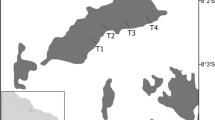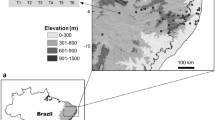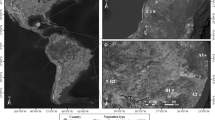Abstract
Habitat fragmentation is a topic widely studied in ecology; however, its effects on the assemblage of the order Scorpiones is less well understood. Aiming to fill this gap, this study assessed the effect of fragmentation on the assemblage of these arachnids in 12 Brazilian Atlantic forest fragments. Five environmental variables were measured (depth and dry mass of litter, understory density, canopy openness, and diameter at breast height of the trees), and the fragment area, vegetation cover, connectivity and elevation assessed. The animals were collected during the dry season and, identified at night with the use of ultraviolet light lamps. The analyzed scorpion assemblage in the landscape was characterized by the species Tityus pusillus, T. stigmurus, T. neglectus, T. brazilae, and Ananteris mauryi, with a maximum of three species co-occurring per fragment. Only the fragment size and the dry mass of litter showed a positive relationship with the composition of scorpions. These results suggest that the habitat of scorpions responds to environmental attributes and landscape metrics at both higher (fragment size) and lower (leaf litter) scales. Our study was able to expand our knowledge of how scorpions respond to habitat changes in the Atlantic Forest. We conclude that fragmentation and habitat quality are determining factors for the assemblage of these arachnids.




Similar content being viewed by others
References
Abensperg-Traun M, Smith GT (1999) How small is too small for small animals? Four terrestrial arthropod species in different-sized remnant woodlands in agricultural Western Australia. Biodivers Conserv 8:709–726. doi:10.1023/A:1008826114741
APAC (2013) Agência Pernambucana de Águas e Clima. http://www.apac.pe.gov.br. Accessed 30 May 2013
Araújo RA, Araújo MS, Gonring AH, Guedes RNC (2005) Impacto da queima controlada da palhada da cana-de-açúcar sobre a comunidade de insetos locais. Neotrop Entomol 34:649–658. doi:10.1590/S1519-566X2005000400016
Bertani R, Nagahama RH, Ortega DRM (2008) Novos registros de Tityus brazilae Lourenço and Eickstedt, 1984 (Scorpiones, Buthidae) para o Brasil, e observações sobre o habitat da espécie. Bol Soc Entomol Aragon 43:513–515
Brazil TK, Lira-da-Silva RM, Porto TJ, Amorim AM, Silva TF (2009) Escorpiões de importância médica do Estado da Bahia, Brasil. Gaz Méd Bahia 79:38–42
Bragagnolo C, Nogueira AA, Pinto-da-Rocha R, Pardini R (2007) Harvestmen in an Atlantic forest fragmented landscape: evaluating assemblage response to habitat quality and quantity. Biol Cons 139:389–400. doi:10.1016/j.biocon.2007.07.008
Brownell P, Polis GA (2001) Scorpion biology and research. Oxford University Press
Cagnolo L, Valladares G, Salvo A, Cabido M, Zak M (2009) Habitat fragmentation and species loss across three interacting trophic levels: effects of life-history and food-web traits. Conserv Biol 23(5):1167–1175. doi:10.1111/j.1523-1739.2009.01214.x
Chapin FS III, Zavaleta ES, Eviner VT, Naylor RL, Vitousek PM, Reynolds HL, Hooper DU, Lavorel S, Sala OE, Hobbie SE, Mack MC, Díaz S (2000) Consequences of changing biodiversity. Nature 405:234–242. doi:10.1038/35012241
Chen J, Saunders SC, Crow TR, Naiman RJ, Brosofske KD, Mroz GD, Brookshire BL, Franklin JF (1999) Microclimate in forest ecosystem and landscape ecology. BioScience 49:288–297. doi:10.2307/1313612
Chen B, Wise DH (1999) Bottom-up limitation of predaceous arthropods in a detritus-based terrestrial food web. Ecology 80:761–772. doi:10.2307/177015
Cincotta RP, Wisnewski J, Engelman R (2000) Human population in the biodiversity hotspots. Nature 404:990–992. doi:10.1038/35010105
Colwell R (2009) EstimateS: statistical estimation of species richness and shared species from samples. Version 8.2. http://viceroy.eeb.uconn.edu/EstimateS. Accessed 30 May 2013
Costa AASS (2011) Diversidade de Araneae e Scorpiones de um fragmento de Floresta Atlântica de Pernambuco em diferentes estágios sucessionais, Dissertation, Universidade Federal de Pernambuco
D’Anunciação PER, Silva MFV, Ferrante L, Assis DS, Casagrande T, Coelho AZG, Amâncio BCS, Pereira TR, Silva VX (2013) Forest fragments surrounded by sugar cane are more inhospitable to terrestrial Amphibian abundance than fragments surrounded by pasture. Inter J Ecol. doi:10.1155/2013/183726
da Silva IA, Pereira AFDN, Barros IC (2014) Fragmentation and loss of habitat: consequences for the fern communities in Atlantic forest remnants in Alagoas, north-eastern Brazil. Plant Ecol Divers 7:509–517. doi:10.1080/17550874.2013.862750
Dean WB (1995) With broadax and firebrand: the destruction of the Brazilian Atlantic Forest. University of California Press, Berkeley, p 482
Dias SC, Candido DM, Brescovit AD (2006) Scorpions from Mata do Buraquinho, João Pessoa, Paraíba, Brazil, with ecological notes on a population of Ananteris mauryi Lourenço (Scorpiones, Buthidae). Rev Bras Zool 23:707–710. doi:10.1590/S0101-81752006000300014
Drakare S, Lennon JJ, Hillebrand H (2006) The imprint of the geographical, evolutionary and ecological context on species–area relationships. Ecol Lett 9:215–227. doi:10.1111/j.1461-0248.2005.00848.x
ESRI (2012) ArcGIS desktop. Release 10.3 [computer software]. Environmental Systems Research Institute, Inc. (ESRI), Redlands, California
Ewers RM, Didham RK (2006) Confounding factors in the detection of species responses to habitat fragmentation. Biol Rev Camb Philos Soc 81:117–142. doi:10.1017/S1464793105006949
Fahrig L (2003) Effects of habitat fragmentation on biodiversity. Annu Rev Ecol Syst 34:487–515. doi:10.1146/annurev.ecolsys.34.011802.132419
Ferraz EMN (2002) Panorama da Floresta Atlântica no Estado de Pernambuco. In Biodiversidade, conservação e uso sustentável da flora do Brasil. Edited by EL Araújo, AN Moura, EVSB Sampaio, LMS Gestinari, JMT Carneiro. Universidade Federal Rural de Pernambuco, Recife. pp 23–26
Filgueiras BKC, Iannuzzi L, Leal IR (2011) Habitat fragmentation alters the structure of dung beetle communities in the Atlantic Forest. Biol Conserv 144:362–369. doi:10.1016/j.biocon.2010.09.013
Frazer GW, Canham CD, Lertzman KP (1999) Gap light analyzer (GLA), version 2.0: imaging software to extract canopy structure and gap light transmission indices from true-colour fisheye photographs, users manual and program documentation. Simon Fraser University, Burnaby, B.C., Canada, and the Institute of Ecosystem Studies, Millbrook, New York
Freitas GCC, Vasconcelos SD (2008) Scorpion fauna of the island of Fernando de Noronha, Brazil: first record of Tityus stigmurus (Thorell 1877) (Arachnida, Buthidae). Biota Neotrop 8:235–237. doi:10.1590/S1676-06032008000200019
Gotelli NJ, Ellison AM (2004) A primer of ecological statistics. Sinauer Associates Inc, Sunderland
He F, Hubbell SP (2011) Species-area relationships always overestimate extinction rates from habitat loss. Nature 473:368–371. doi:10.1038/nature09985
Hidalgo B, Goodman M (2013) Multivariate or multivariable regression? Am J Public Health 103(1):1–3. doi:10.2105/AJPH.2012.300897
Hill JK, Gray MA, Khen CV, Benedick S, Tawatao N, Hamer KC (2011) Ecological impacts of tropical forest fragmentation: How consistent are patterns in species richness and nestedness? Philos Trans R Soc B 366(1582):3265–3276. doi:10.1098/rstb.2011.0050
Horvarth R, Magura T, Szinetár C, Eichardt J, Tóthmérész B (2013) Large and least isolated fragments preserve habitat specialist spiders best in dry sandy grasslands in Hungary. Biodivers Conserv 22(10):2139–2150. doi:10.1007/s10531-013-0439-y
Kruess A, Tscharntke T (2000) Species richness and parasitism in a fragmented landscape: experiments and field studies with insects on Vicia sepium. Oecologia 122:129–137. doi:10.1007/PL00008829
Kutner MH, Nachtsheim CJ, Neter J, Li W (2005) Applied linear statistical models. McGraw-Hill, New York
Laurance WF, Lovejoy TE, Vasconcelos HL, Bruna EM, Didham RK, Stouffer PC, Gascon C, Bierregaard RO, Laurance SG, Sampaio E (2002) Ecosystem decay of Amazonian forest fragments: a 22-year investigation. Conserv Biol 16:605–618. doi:10.1046/j.1523-1739.2002.01025.x
Leal IR, Filgueiras BKC, Gomes JP, Iannuzzi L, Andersen AN (2012) Effects of habitat fragmentation on ant richness and functional composition in Brazilian Atlantic forest. Biodivers Conserv 21:1687–1701. doi:10.1007/s10531-012-0271-9
Legendre P, Legendre L (1998) Numerical ecology. Elsevier, Oxford
Lepš J, Šmilauer P (2003) Multivariate analysis of ecological data using CANOCO. Cambridge University Press, Cambridge
Lira AFA, Albuquerque CMR (2014) Diversity of scorpions (Chelicerata: Arachnida) in the Atlantic Forest in Pernambuco, northeastern Brazil. Check List 10:1331–1335
Lira AFA, DeSouza AM (2014) Microhabitat use by scorpion species (Arachnida: Scorpiones) in the montane Atlantic Rain Forest, Brazil. Rev Iber Aracnol 24:107–108
Lira AFA, Souza AM, Costa AASS, Albuquerque CMR (2013) Spatio-temporal microhabitat use by two co-occurring species of scorpions in Atlantic rainforest in Brazil. Zool 116:182–185. doi:10.1016/j.zool.2013.01.002
Lira AFA, Rego FNAA, Albuquerque CMR (2015) How important are environmental factors for the population structure of co-occurring scorpion species in a tropical forest? Can J Zool 93:15–19. doi:10.1139/cjz-2014-0238
Lôbo D, Leão T, Melo FPL, Santos AMM, Tabarelli M (2011) Forest fragmentation drives Atlantic forest of northeastern Brazil to biotic homogenization. Divers Distrib 17:287–296. doi:10.1111/j.1472-4642.2010.00739.x
Lourenco WR (2002) Scorpions of Brazil. Les Éditions de l’If, Paris 308
Lourenço WR (2008) Parthenogenesis in scorpions: some history—new data. J Venom Anim Toxins 14:19–44. doi:10.1590/S1678-91992008000100003
Lourenço WR, Eickstedt VRD (1988) Sinopse das espécies de Tityus do Nordeste do Brasil, com a redescrição da T. neglectus Mello-Leitão (Scorpiones, Burthidae). Rev Bras Zool 5:399–408. doi:10.1590/S0101-81751988000300005
Macedo N, Araújo JR (2000) Effects of sugarcane burning on predator insects. An Soc Entomol Bras 29:71–77. doi:10.1590/S0301-80592000000100009
Medianero E, Castaño-Meneses G, Tishechkin A, Basset Y, Barrios H, Ødegaard F, Cline AR, Bail J (2007) Influence of local illumination and plant composition on the spatial and seasonal distribution of litterdwelling arthropods in a tropical rainforest. Pedobiologia 51:131–145. doi:10.1016/j.pedobi.2007.03.004
McCune B, Grace JB (2002) Analysis of ecological communities. MjM Software Design, Gleneden Beach
Myers N, Mittermeier RA, Mittermeier CG, Fonseca GAB, Kent J (2000) Biodiversity hotspots for conservation priorities. Nature 403:853–858. doi:10.1038/35002501
Oksanen J, Blanchet FG, Kindt R, Legendre P, Minchin PR, O’Hara RB, Simpson GL, Solymos P, Stevens MHH, Wagner H (2016). vegan: community ecology package. R package version 2.3-4. https://CRAN.R-project.org/package=vegan
Pardini R, Faria D, Accacio GM, Laps RR, Mariano-Neto E, Paciencia MLB, Dixo M, Baumgartem J (2009) The challenge of maintaining Atlantic forest biodiversity: a multi-taxa conservation assessment of specialist and generalist species in an agro-forestry mosaic in southern Bahia. Biol Conserv 142:1178–1190. doi:10.1016/j.biocon.2009.02.010
Pimm SL, Jenkins CN, Abell R, Brooks TM, Gittleman JL, Joppa LN, Raven PH, Roberts CM, Sexton JO (2014) The biodiversity of species and their rates of extinction, distribution, and protection. Science 344(6187):1246752. doi:10.1126/science.1246752
Polis GA (1990) The biology of scorpions. Stanford University Press, Stanford
Ribeiro MC, Metzger JP, Martensen AC, Ponzoni FJ, Hirota MM (2009) The Brazilian Atlantic Forest: How much is left, and how is the remaining forest distributed? Implications for conservation. Biol Conserv 142:1141–1153
Rinaldi IMP, Forti LC (1996) Strategies for habitat use among species of hunting spiders (Araneomorphae, Dionycha) in natural and artificial biotopes from southeastern Brazil. Acta Biol Par 25:115–139. doi:10.5380/abpr.v25i0.698
Santos MDS, Porto TJ, Lira-da-Silva RM, Brazil TK (2014) Description of the male of Tityus kuryi Lourenço, 1997 and notes about males of Tityus stigmurus (Thorell, 1877) and Tityus serrulatus Lutz & Mello, 1922 (Scorpiones, Buthidae). Zookeys 435:49–61. doi:10.3897/zookeys.435.6694
Saunders DA, Hobbs RJ, Margules CR (1991) Biological consequences of ecosystem fragmentation: a review. Conserv Biol 5:18–32. doi:10.1111/j.1523-1739.1991.tb00384.x
Smith GT (1995) Species richness, habitat and conservation of scorpions in the Western Australian wheatbelt. Rec West Aust Mus 52:55–66
Stockman RE, Ythier E (2010) Scorpions of the world. NAP editions, Paris
Tabarelli M, Silva JMC, Gascon C (2004) Forest fragmentation, synergisms and the impoverishment of neotropical forests. Biodivers Conserv 13:1419–1425. doi:10.1023/B:BIOC.0000019398.36045.1b
ter Braak CJF, Šmilauer P (2002) CANOCO reference manual and CanoDraw for Windows user’s guide: software for canonical community ordination. Version 4.5. Microcomputer Power, Ithaca, New York
Tilman D, Fargione J, Wolff B, D’Antonio C, Dobson A, Howarth R, Schindler D, Schlesinger WH, Simberloff D, Swackhamer D (2001) Forecasting agriculturally driven global environmental change. Science 292(5515):281–284. doi:10.1126/science.1057544
Uehara-Prado M, Brown KS, Freitas AVL (2007) Species richness, composition and abundance of fruit-feeding butterflies in the Brazilian Atlantic Forest: comparison between a fragmented and a continuous landscape. Glob Ecol Biogeogr 16:43–54. doi:10.1111/j.1466-8238.2006.00267.x
Vitousek PM, Mooney HA, Lubchenco J, Melillo JM (1997) Human domination of Earth’s ecosystems. Science 277(5325):494–499. doi:10.1007/978-0-387-73412-5_1
Wilkinson L (2009) SYSTAT version 13. SYSTAT Software Inc., Chicago
Wilson EO (1990) Success and dominance in ecosystems: the case of the social insects. Ecology Institute, Oldendorf
Zar JH (1999) Biostatistical analysis. Prentice Hall, New Jersey
Zuur AF, Ieno EN, Elphick CS (2010) A protocol for data exploration to avoid common statistical problems. Methods Ecol Evol 1:3–14. doi:10.1111/j.2041-210X.2009.00001.x
Acknowledgments
We are grateful to Mario Jorge for permission to use the areas for sampling. We are also grateful to Coordenação de Aperfeiçoamento de Pessoal de Nível Superior (CAPES) for granting a PhD scholarship to A.F.A. Lira and A.M. DeSouza and to Renato Salomão, Laís Pordeus, and Evânia Freire, and to Lucas Cavalcanti for technical assistance during field work.
Author information
Authors and Affiliations
Corresponding author
Rights and permissions
About this article
Cite this article
Lira, A.F.A., de Araújo, V.L.N., DeSouza, A.M. et al. The effect of habitat fragmentation on the scorpion assemblage of a Brazilian Atlantic Forest. J Insect Conserv 20, 457–466 (2016). https://doi.org/10.1007/s10841-016-9878-6
Received:
Accepted:
Published:
Issue Date:
DOI: https://doi.org/10.1007/s10841-016-9878-6




